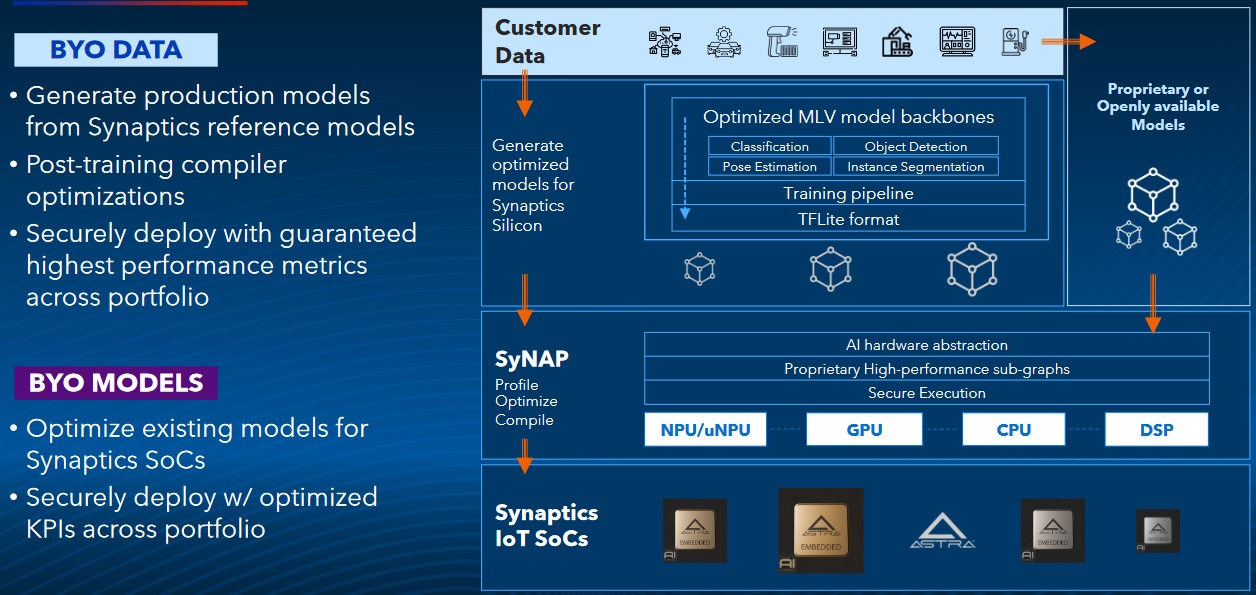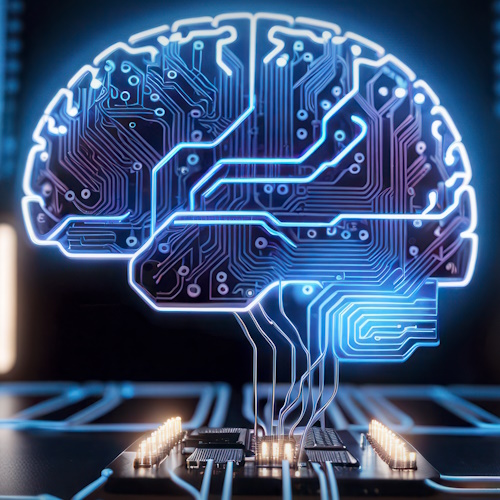I have two questions for you. First, what are the three key elements of any platform intended for the internet of things (IoT) and edge computing, both of which are where the internet “rubber” meets the real-world “road”? Second, what springs to your mind when you hear someone drop the company Synaptics into the conversation?
Let’s start with the second question first because… why not? It’s amazing to me that Synaptics was founded in 1986, which is 38 years ago as I pen these words. I was young, bright-eyed, and bushy-tailed in those far-off days… but we digress. Many people associate Synaptics with human-machine interface (HMI) technology, and rightly so, but the company has evolved to be so much more than this.
It doesn’t hurt to remind ourselves that Synaptics is credited with the invention of many of the HMI technologies we now take for granted, such as the computer touchpad, the click wheel on the classic iPod, touch sensors on Android phones, and touch and display driver integrated chips (TDDI). This is all very impressive right from the get-go. I mean, can you even remember notepads and laptop computers without touchpads?
Between you and me (shhh), even the backstory to the original Synaptics touchpad technology is interesting. The company was founded by industry legends Frederico Faggin and Carver Mead. Frederico is an Italian-American physicist, engineer, inventor, and entrepreneur who is best known for his role in designing the Intel 4004, which was the first commercial microprocessor. Meanwhile, Carver is an American scientist and engineer who needs no introduction as being a pioneer of modern microelectronics.
Have you ever thought about the origin of the name “Synaptics”? Did it ever strike you that this could be related to the point at which electrical signals move from one nerve cell to another in the brain? Could any of this possibly be associated with artificial neural networks (ANNs), artificial intelligence (AI), machine learning (ML), etc.? Surely not. I mean, we’re talking about a company founded in 1986, but the collective consciousness didn’t become aware that AI was even a “thing” until circa 2010 (give or take).
In fact, when they founded Synaptics, Frederico and Carver used their research on neural networks and transistors on chips to build pattern recognition products. In 1991, Synaptics patented a refined “winner take all” circuit for teaching neural networks how to recognize patterns and images. In 1992, the company used the pattern recognition techniques it developed to build the world’s first touchpad for laptop computers, thereby allowing users to control the cursor and “click” with no additional mechanical buttons. This proved to be such an intuitive interface that it was quickly adopted by leading computer creators.
Let’s return to my first question, which pertained to the key elements required by any platform intended for edge computing and the “things” part of the IoT moniker. These can be summarized as Sensing, Processing, and Connectivity.

(Source: Synaptics)
Based on my waffling so far, it may not surprise you to learn that, following a series of strategic acquisitions (e.g., Conexant Systems and the Multimedia Business Unit of Marvell Technology in 2017), Synaptics now covers all the bases, including owning a vast suite of sophisticated algorithms (with both hardware and software implementations as appropriate).
I was just chatting with Augustine Nebu Philips, who is Senior Director, Strategy and Business Development at Synaptics. Nebu started by reminding me that Synaptics has an intelligent sensing division, which encompasses all the touch technology, biometrics technologies (like fingerprint identification), and some of the display technologies. Also, they have a connectivity division that embraces Zigbee, Bluetooth, Wi-Fi, and GPS/GNSS, all tuned to support the edge computing and IoT markets.
However, the area that’s of most interest to us here is the processing division. This is responsible for the creation of a family of edge AI processors in the form of system-on-chip (SoC) devices, including the SL-Series of high-performance microprocessor units (MPUs) capable of running the Linux and Android operating systems, the SR-Series of high-performance microcontroller units (MCUs) that are more suited to real-time operating system (RTOS) deployments, and a suite of Connectivity MCUs.

Meet the Synaptics family of edge AI processors (Source: Synaptics)
“What makes these devices deserving of the ‘edge AI’ qualifier?” I hear you cry. Well, apart from boasting clusters of high-performance Arm processor cores, graphics processing unit (GPU) cores, and neural processing unit (NPU) cores, along with security engines, display engines, image signal processing engines… all I can say is that these are edge AI processors if ever I saw one.
All of which goes to explain why the folks at Synaptics refer to this Astra family of processors—along with associated software like their adaptive AI framework—as “The AI-native compute platform for the IoT.”
Have you ever been to a fast-food restaurant that has a humongous menu that covers almost every form of cuisine you can think of? I don’t know about you, but I always doubt they can be good at everything. I prefer restaurants that pick a genre and stick to it, honing their skills in their targeted domain. The same thing applies to technology companies. It’s easy for them to get excited and try to target any market that moves, as it were.
By comparison, Synaptics is firmly focused on the device edge market, including consumer, enterprise, and industrial, but not (or less so) automotive, and certainly not on-premises edge, access and metro edge, etc.

Synaptics is focusing on solutions for the device edge market (Source: Synaptics)
The device edge market encompasses everything we see in the image above, from smart homes and smart buildings and smart cities, to drones and robots, to wearables and healthcare, to… again, the list goes on. The compute silicon portion of the device edge market is currently running around $25 billion a year and growing at 12% to 15% per year, so Synaptics is certainly in the right place at the right time and poised to take the world by storm.
Nebu was very keen for me to understand that Astra is all about “democratizing” edge AI so that more developers can incorporate AI into their applications. Synaptics is addressing this using a combination of open-source and standards-based approaches. For example, observe SyNAP in the image below. This accepts any trained model in a standard format (Caffe, TensorFlow, PyTorch…), performs tasks like quantization and pruning, and generates a run-time that will provide the best performance (both compute and inference) on the selected Synaptics silicon.

Meet the Synaptics open edge AI framework (Source: Synaptics)
But wait, there’s more, because in addition to supporting a Bring Your Own Model (BYOM) flow, the folks at Synaptics recognize that different companies are at different stages on their AI journeys. Many companies have data that they’ve collected over the years, but they don’t know how to create an AI that can take full advantage of this data.
To address this, Synaptics are going to provide a suite of what they refer to as “backbone models” that support a Bring Your Own Data (BYOD) scenario. The idea is that users can take these models, which perform tasks like object detection, and re-train them using their own data.
What? You want more? How about the Synaptics Astra Machina Foundation Series? This is a modular developer kit for the Synaptics SL-Series of high-performance embedded processors.

Meet the Synaptics Astra Machina Foundation Series (Source: Synaptics)
Just looking at the box makes me want to play with one of these bodacious beauties, and I think the use of the Machina moniker is inspired.
In linguistics, a calque is a word or phrase borrowed from another language by literal word-for-word or root-for-root translation. Deus ex machina is a Latin calque from ancient Greek. The English translation is “god from the machine.” This was a plot device used in Greek plays—both tragedies and comedies—whereby a seemingly unsolvable problem in a story was suddenly or abruptly resolved by an unexpected and unlikely occurrence (like an actor portraying a god being lowered from the ceiling using a crane or hoist, i.e., a machine). That’s the way I think of the Astra Machina—something that’s going to resolve hitherto seemingly unsolvable problems.
I could waffle on… and on… and on… (much like my dear old mother, the trick is to get us to stop talking), but I fear I’ve waffled too much. What’s your take on all of this?






One thought on “BYOD or BYOM to Synaptics’ AI-Native Edge Compute Party”